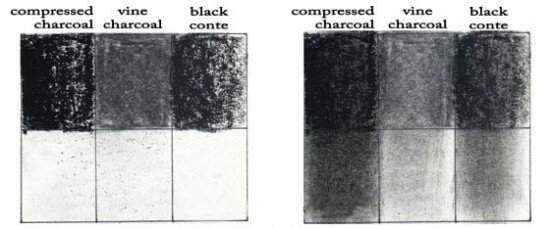Using Skim Milk as a Drawing Fixative
Milk used as a fixative on charcoal and Conte life drawing
I heard a few years ago about using skim milk as a fixative for drawings. This week I decided to put it to the test. I compared it to Krylon Workable Fixative. I sprayed the milk through an airbrush to simulate the mist produced by the aerosol can of fixative. Milk could also be applied with an atomizer (available at any well stocked art store) or pump spray bottle, such as a reclaimed hair spray pump. According to the Van Gogh Museum’s web site, Van Gogh used to pour entire glasses of milk over his pencil drawings, so I think one has a bit of leeway in application while still producing good results.
Van Gogh used to pour entire glasses of milk over his pencil drawings
Check out Van Gogh’s pencil drawing, ‘Worn Out’ which was fixed with a tall glass of milk. Van Gogh apparently liked the matte effect milk had on heavy graphite marks. The experiment below was done with compressed charcoal, vine charcoal, and black Conte Crayon on low quality drawing paper of about a 30-40 pound weight. The milk did give the compressed charcoal and the Conte a bit of a gloss finish in my experiment, which was the only noticeable difference between the two fixatives. Given the overall excellent results of the milk, I think I will be doing a few more experiments with other media on better quality papers and wood panels. I will post the results as they come along. And no, the milk does not smell or turn the paper yellow.
Benefits of using milk as a fixative for drawings
Non-Toxic. Check out the label of your fixative. Does it contain xylene? Xylene is a derivative of benzene, and can cause headaches, lack of muscle coordination, dizziness, confusion, death, irritation of the throat, nose, eyes, and skin, difficulty breathing, unconsciousness, delayed growth, development, and death in fetuses, groundwater contamination, and it stinks.
Cheap. 11 oz cans of spray fix retail for about $7.
Readily available.
Nothing for the land fill (no you can’t recycle pressurized spray cans, even if they are empty)
Can be used in class or in unventilated areas. Your instructor will be impressed if you bust out an atomizer and a carton of milk. They’ve probably never even heard of it. Bust out a can of spray fix and you’ll be accosted before you even get the cap off.
Benefits of chemical fixative
convenience (give me convenience or give me death!)
shelf life (I’ve been using the same can of fixative for ten years)
quicker drying time. Milk really needs thin coats and adequate drying times to prevent wrinkles and puddles.
water-resistant. Acrylic fixative essentially creates an acrylic barrier between your drawing and the rest of the world.
Workable. Milk didn’t do as well in accepting more pigment. Perhaps thinner coats or an additive would improve this. update- with thin coats, milk has great workable qualities 1/8/2012
Variety of finishes such as matte, satin, gloss, and workable
milk does seem to leave a slight satin finish which may be undesirable in some circumstances
No Fixative
The drawing below and on the left shows a test swatch each of compressed charcoal, vine charcoal, and black Conte Crayon. The image on the right is the same drawing after being wiped with a paper towel. All three swatches show severe smearing.
No fixative, before and after smearing
Krylon Fixative- one moderate coat, before and after
The drawing below shows swatches sprayed with what I would call a medium coat of Krylon Fixative. On the left are the original swatches, on the right is an image of the same swatches that have been smeared with a paper towel. A single coat does not provide full coverage, so some smearing was expected. A single coat of fixative applied to the Conte Crayon would be adequate to prevent most smearing in all but the heaviest applications of pigment, while additional coats would be required for the charcoals.
One coat of chemical fixative, before and after smear test
Milk fixative – one moderate coat, before and after
Again a before and after shot of the same swatches. The milk fixative is comparable to the Krylon. In this test, the milk appears to slightly out perform the chemical fix, but is probably due to a slightly heavier coat of milk, or a lighter application of pigments.
One coat milk fixative, before and after smearing
Swatches fixed with chemical fixative. The image on the right after smearing with paper towel.
Krylon Fixative – 3 coats, before and after
3 coats of fixative and there is no noticeable smearing. A very small amount of pigment transferred to the paper towel after moderate rubbing.
Chemical fixative, 3 coats
Before and after moderate rubbing on swatches applied with three coats of chemical fixative. No noticeable difference.
Milk fixative – 3 coats, before and after
3 coats milk fixative
Again comparable to chemical fixative. No noticeable difference before rubbing and after.
Surprisingly, the milk performed as well as chemical fixative in these tests. Of course chemical fixative has a place in the art world, but given the growing number of artists and the decreasing tolerance of our planet to absorb such wasteful and toxic products such as spray fix, perhaps a few earth-friendly substitutions are in order.
3 coats milk fixative on dry media




